#i know that we like. if we were to get trans woman kon. it would have to go with changing her name and everything
Explore tagged Tumblr posts
Text
“A Queer Who Cares” : The Intersection of Class and Queerness in Tokyo Godfathers

Tokyo Godfathers is a Japanese animated film, made in 2003, that follows the adventures of three homeless friends on Christmas Eve in Tokyo, Japan. Throughout the movie, we follow Hana, a transwoman and former drag queen, Gin, a middle-aged man with a gambling addiction, and Miyuki, a teenage runaway, as they find a baby in a trash can and spend Christmas Day trying to reunite the child with her mother. A comedic adventure quickly ensues, as the chaotic but loving trio, do their best to take care of their new baby, solve the mystery of her appearance, and all the while combat the dangers and prejudices that come with being homeless. Though predominantly a comedy, the film also strays away from its humorous tone and delves deep into the characters’ complex backstories, emotionally exploring the myriad of reasons why Hana, Gin, and Miyuki are homeless and why getting the baby back to her mother is so important for each of them. Directed by the famous Satoshi Kon and loosely based on the 1913 novel “The Three Godfathers”, the film explores themes of parenthood, found families, classism, transphobia, and addiction, and illuminates the complex ways in which these forces interact and impact daily life. In essence, Tokyo Godfathers effectively explores themes of transphobia and the intersection of classism and queerness, and though not entirely unproblematic, is unique and powerful in its complex characterization of both Hana as a character and the oppressions she faces as a transwoman who is homeless.
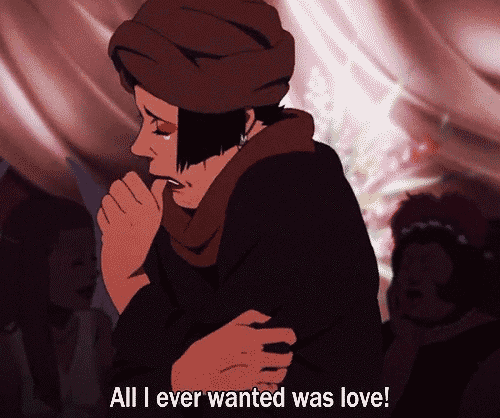
(Hana speaking about her desire to be loved)
Before beginning, it is important to note that the following analysis is of the 2020 English dubbed re-release of Tokyo Godfathers by GKIDS. As of now, there are many fan-subbed versions of the film circulating on the internet that misgender Hana in their subtitles. The GKIDS re-release does not so I will not be addressing that form of transphobia in my analysis. Similarly, in the original Japanese version, Hana is voiced by a man, and the fluctuations of her voice, from high and feminine when she is happy, to low and masculine when she wants to be intimidating, is present and follows a very transphobic trope in comedy. In the GKIDS dubbed version, Hana is voiced by Shakina Nayfack, a transwoman, actress, and activist, and these vocal fluctuations are not present so, once again, I will not be addressing that form of transphobia, as it was not present in the updated version that I watched.

How Shakina Nayfack used her voice to reclaim trans representation in animation
(A short article on Shakina Nayfack, the English voice actress for Hana in the 2020 GKIDS re-release)
youtube
Though Tokyo Godfathers does not have the popularity or mainstream attention to be considered a breakout text, it’s humanizing and complex characterization of Hana breaks traditional transphobic tropes, particularly in comedy, that lends itself to “creat[ing] small cracks in the glass ceiling of cultural consciousness and makes room for future breaks” (Cavalcante, 2017, p. 4). Hana is the main protagonist of the film. She is both the center of comedic relief, the leader of her found family and the driver of the plot as a whole. It is through her desire to fulfill her dream of becoming a mother, and her desperate need to understand why parents abandon their children (as her parents did to her), that motivates her, and in turn, her friends, to find the child’s parents themselves, instead of going to the police. It is in this complexity that Hana, “breaks historical representation paradigms” of both trans characters and queer characters as a whole (Cavalcante, 2017, p. 2). In her desperate search to love and be loved, Hana is immediately humanized, her identity centered in love and family, and not in her gender or sexuality, as so many queer characters are. In addition, she is not portrayed as “sexless” as is the norm for queer characters, wherein they can exist in media as long as their love stories and intimate desires do not. Though very subtle, Hana is the only character in the movie that has a love interest, Gin, and she had a boyfriend, who died, but is still a key part of her characterization. Though these love stories are not centered in the film, they are the only ones in the movie, and this exclusive existence, unique to Hana, illustrates their importance to both the themes of the movie and Hana’s character.
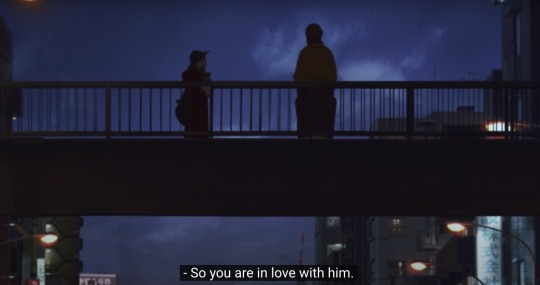
(Miyuki asks Hana about her feelings for Gin)
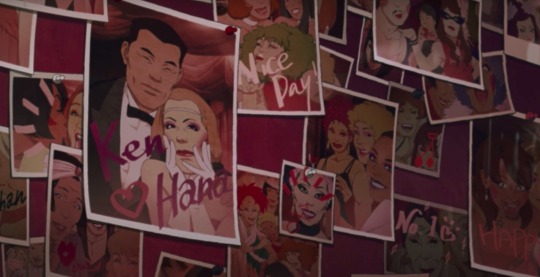
(A photo of Hana and her ex-boyfriend Ken at the club she once worked at)
That is not to say that the queer representation in this film is by any means perfect. As mentioned, the movie is a comedy and thus falls into the historical “preponderance of these representations occurring in the comedy”, especially given that Hana is the comedic center (Dow, 2001, p.130). Even more so, there are instances in which Hana’s trans identity is stereotyped and used as the joke itself. In one scene, she flirts with a cab driver knowing that he is uncomfortable by the fact that she is a trans woman, and his transphobia is framed as comedic. She also has a very flamboyant personality, with sharp emotional highs, and equally dramatic lows, that once again plays into stereotypical representations of transwomen as over-the-top and overly dramatized to the point of ridiculousness. In line with this, her previous line of work was as a drag queen, and though scenes of her in the drag community are dominated by a sense of love and community, it still plays into already established tropes of transwoman living as a performance. In these ways, her representation at times leans towards the role of the “clown...putting on a show for The Other” where it is “never quite clear whether we are laughing with or at this figure” (Hall,1995, p. 22). However, as mentioned above, Hana’s complex and nuanced backstory, combined with her frequent acts of heroism and her leadership role, make it so she is deeply humanized. Though her dramatic personality falls into these stereotypical tropes at times, it does not detract from her character arc of motherhood and finding love, a nuance that is missing from many stories of trans women in media.

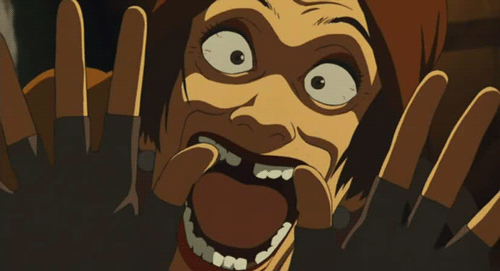
(As pictured, Hana’s emotions are very dramatized and quickly jump from very high to very low)
This nuance is heightened through the intersection of classism and queerness, which is an equally prevalent theme throughout the film. In particular, class struggles are illustrated through medical care. At one point, Hana falls ill, and Gin is forced to give away his life savings in order to pay for her treatment. It is also here where Hana’s gender identity is questioned, as the hospital houses her in the men’s ward, and she explains that she “is not pleased with this”. This particular intersection of class and queerness within a medical setting is impactful given the long and “oppressive role of medicine in trans people’s lives” (Keegan, 2016, p. 607) and the strong tendency of media to tell trans folks stories, about both life and transition, in a way that is medicalized. For Hana, the discrimination she experiences at the hospital, and her inability to pay for her treatment, illustrate the violence of intersecting oppressions of queerness and homelessness in medical systems, while also straying away from the problematic representation of trans folks that are centered around a rhetoric of medicalization. More visually, the family is also a key illustrative example of how class and queerness are explored. The trio is constantly visually contrasted with traditional Japanese families in a variety of settings. This harkens back to ideas of “alternative forms” of families that queer folks create and this difference is visually exasperated by the trio’s homelessness, making them stand out in whatever space they are in (Keegan, 2016, p. 607).

(An angel asks Gin if he would rather have her magic or an ambulance. He chooses the ambulance.)
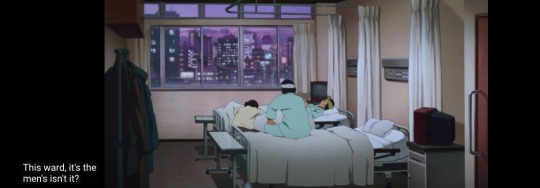
(Hana in the hospital. The subtitle reads “This ward, it’s the men’s isn't it?”)
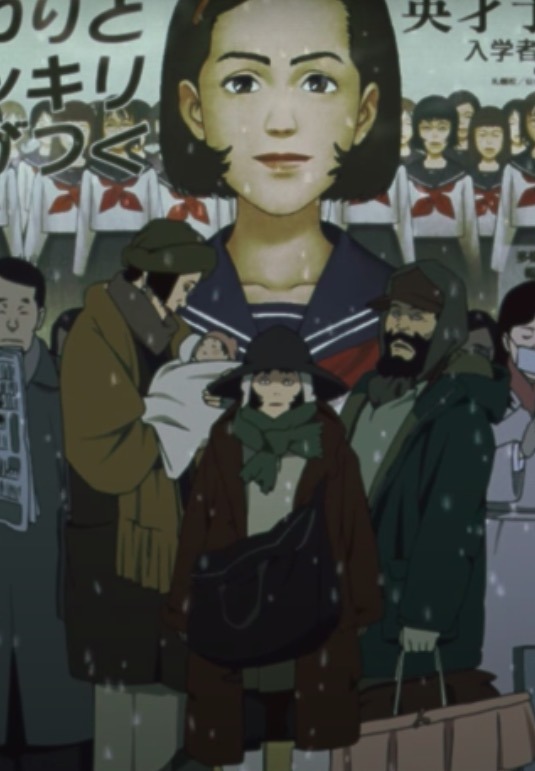
(One of many scenes where the trio is set up in familial positions)
As a queer, white woman living in the United States my subject positionality had a great effect on how I consumed the movie. Most notably, I was born and raised in Western society, and given that this film is Japanese and made for Japanese audiences, there is a variety of cultural norms and perceptions that I did not pick up on because of my lack of familiarity with them. In the same vein, I watched this movie translated into English and, as with every translated work, there are words and subtle, yet important, nuances in the language that were very likely lost to me as a viewer. My identity as a queer woman made it so that I was drawn to Hana as a character and was very moved by her deep desire to be a mother. The movie is steeped in images of Hana and her friends encompassing the idea of a non-traditional family, and since I would love a family of my own one day and I expect that to look different than the dominant nuclear family norm, I really focused my experience on the variety of nontraditional families that this movie shows, all of them as loving as the next.
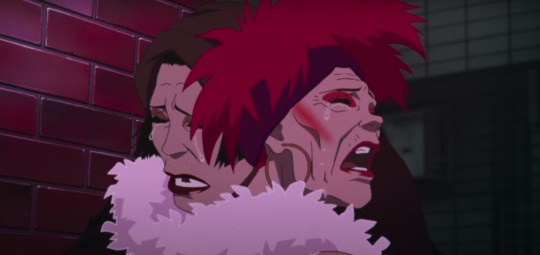
(Hana and her drag mother reuniting)
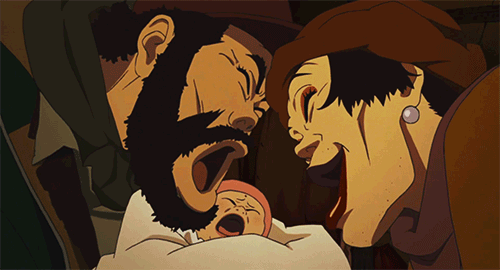
(Hana and her family)
As a whole, Tokyo Godfathers, though not without its faults, is a refreshing take on the traditional feel-good Christmas movie trope, delving into class and queerness, and using the two to explore what it really means to be a family that is loving and kind. Spoiler alert, that family looks a little something like one ex-drag queen, one man with a gambling addiction, a teenage runaway who loves cats, and their baby they found in a dumpster.
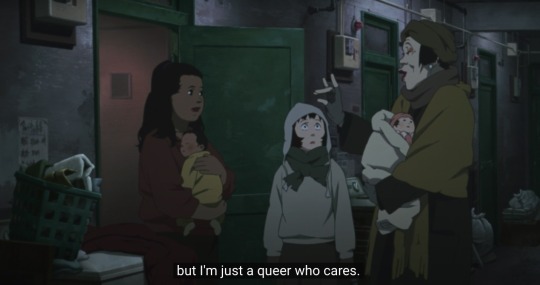
Sources
Dow, Bonnie (2001). “Ellen, Television, and the Politics of Gay and Lesbian Visibility.” Critical Studies in Media Communication 18(2), 123-140.
Cavalcante, Andre (2017). “Breaking into Transgender Life: Transgender Audiences’ Experiences With ‘First of Its Kind’ Visibility in Popular Media.” Communication, Culture & Critique, 1-18.
Keegan, Cáel (2016). “Tongues without Bodies: The Wachowskis’ Sense8.” Transgender Studies Quarterly 3(3–4), 605-610.
Hall, Stuart (1995). “The Whites of their Eyes: Racist Ideologies and the Media,” in Gender, Race, and Class in Media 3rd ed., pp. 18-22.
#tokyo godfathers#queer studies#Queer Movie Review#trans woman#trans representation#found family#christmas movies
195 notes
·
View notes
Text
Dino Watches Anime (Oct 26)
Recently Completed!
Tokyo Godfathers
Score: 10/10
There’s a reason why I gave this such a rare high rating. When I was watching it, I was internally like, “*excitement noises* I have not been this excited over an anime in such a long time, let alone for an anime movie. EVERYONE SHUT UP SO I CAN WATCH THIS EVEN IF I DON’T UNDERSTAND WHAT THEY’RE SAYING.”
It’s not often that you come across really good movies, let alone masterpieces like this movie. The art is so good, the story made me feel like it was Christmas in October, and the characters really made me connect.
I know the subtitles used a whole lot of gay slurs and things like that, but Hana (the trans character in this tale) is treated well if we get past that huge hurdle. She truly owns up to herself. She doesn’t care what she’s called. She gets mad at people who misgender her. She gets mad if she’s forced to go to a men’s facility. She wants people to call her “an old hag” rather than “an old coot”. She just wants to be a mother even if she isn’t “biologically a woman” who can bear children. So when she comes across this kid, she thinks, “I will finally be a mother!” These are issues that real people face. These are issues that cisgendered people take for granted.
Madhouse really knocked it out of the park. Satoshi Kon is one of the biggest creators and directors in anime history. He’s known for horror and psychological works like Perfect Blue, Paprika, and Millennium Actress. I never expected him to be this good at making a movie that could move my soul like this. The characters were so far from perfect, yet I wanted the best for each of them. The way it handled everything was masterful. The dialogue worked so well and was witty, the voice actors (despite the main three not being in anything else for the most part) were so good at giving life to their characters, and the art blew me away in 2019 even though this was released in 2003. The only thing I didn’t quite like as much was the score during some parts of the movie, but it was subjectively good and just wasn’t to my taste (the Noragami soundtrack wasn’t a fav of mine either).
Just... watch the movie. If you can watch it around Christmas. It’s good for you.
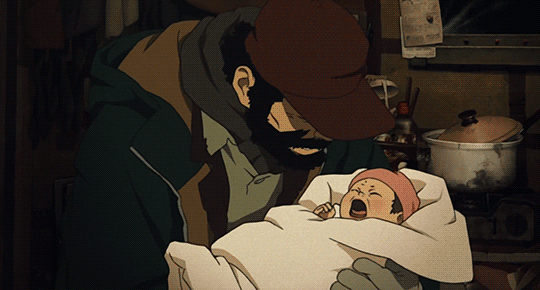
Saiunkoku Monogatari
Score: 7.4/10
Yes, I binge-watched all 39 episodes in two days, what’s it to ya?! In reality, I just boosted the speed of the video.
Me throughout this show: Why do you all have triangle heads? What’s with that?
Okay, it’s the art style, and a lot of shoujo anime go with the concept that it looks good. Once you get over the art hurdle making me believe this was created in the early 2000s despite it being 3 years younger than Tokyo Godfathers, this turns out to be a really nice show. I just can’t believe they’re BOTH from Madhouse.
Remember Snow White with the Red Hair? Remember Akatsuki no Yona? If you liked those shows, you’re going to like this one... except it relies more on the political plot. It’s mostly about a woman wanting to pursue her dreams of being a politician in a male-dominated world. She’s entasked with helping this mess of a king to get his act together, and as much as I can try to prove that it’s surprisingly progressive (given the art and genre), I think that’d be spoiling it a little. The only character that actually bothered me was the prince who was voiced by Tomokazu Seki who honestly was a bit annoying and sounded so fake for me. However, this anime made me appreciate Hikaru Midorikawa’s voice as well as Houko Kuwashima who I’ve only heard voicing dead moms and only a few good characters here and there. Seriously, both of their voices are great. Toshiyuki Morikawa sounds good too, but we already knew that. I don’t like the OP or ED (or a whole lot of the music), but that’s the case for a lot of these 2005-era anime. Just like a lot of the anime on MAL, I do think this is an underrated show, but it does have its pitfalls if you’re just craving for a quick shoujo without any politics.
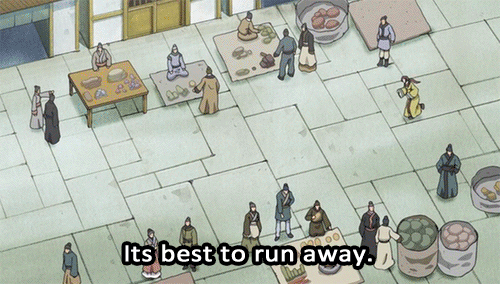
Full Metal Panic: Second Raid
Score: 7/10
I binge-watched this entire season while my parents were out for dinner and something else. It only took me a couple of hours because I boosted the speed.
I wanted to get a gif specifically from this season, so this one will have to do. So much wasted potential will this character (who’s one of two twins). I know they were trying to play the whole “twincest” thing, but I’m personally not a fan. They provided some cool fight scenes even at a certain cringe cost. The fact that Kyoto Animation animated this bumped the art from a 3 to an 8. It’s crazy how much the quality jumped after a new studio took over. Unfortunately, they didn’t take care of the next season. I know the main ship in the series is pretty clear, but this season made it closer to canon (too bad it took around 13 years to make the next season).
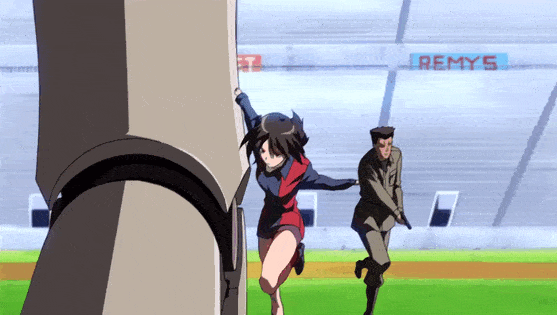
Kara no Kyoukai (movies: 5, 6, 7)
Score: Part Five: 7.5/10 Part Six: 5.8/10 Part Seven: 8.2/10
Not gonna lie, I watched the first four movies over a year ago and retained nothing. I had to read the Wikia to assist me and to begin with, I watched this to get into the “Type-Moon” universe (which consists of this and the Fate nonsense stuff), Yuki Kajiura’s score, and Maaya Sakamoto and Kenichi Suzumura voicing a couple. The score would probably change if I’d watched them regularly, but I digress because I watched movies 5-7 in one afternoon. Ufotable was pretty good at animating this and the voice acting worked really well. Yuki Kajiura’s music didn’t hit well at first when I was first watching the first few movies over a year ago because it wasn’t what I envisioned the score being, but once you get into the mood and mindset, it adds so much to the story. Although, I still really didn’t like part six. I thought it was a complete flop because I just want to get rid of anyone who believes i*cest is an okay thing. This isn’t Alabama. Go home. Not else to say here because this took so much commitment that I doubt anyone would watch it.

Paranoia Agent
Score: 8.6/10
With spoopy month coming to a close (already?!) I watched this anime earlier this month, but I forgot to write about it. That’s partly because there’s so much to unpack here. This was a thriller, psychological, horror anime by Satoshi Kon. That’s right, the first anime above was also done with him in the director’s seat. This anime was smart. There’s a reason why Robin Williams likes it! It was scary in the best of ways. It revealed a part of society that we see all the time but don’t talk about (especially in Japanese society where emotions are better kept concealed). Just the opening alone made me feel uneasy. The OP and ED were simplistic yet worked. I binge-watched the whole series because it was that gripping.
It was a little confusing at times, but that’s also because that’s just a common thing with horror anime. That suspense keeps us going. It keeps us on the edge of our seats. Who’s going to be the next victim of Shounen Bat? Episode 8 came out of nowhere for me, and I liked it. There were several scenes that sent shivers down my spine in the best way possible. It isn’t always “scary”, but it gives suspense.

Aoi Bungaku
This one is going to be reviewed a little differently. Since it has specific arcs, I’m going to review them as such!
Ningen Shikkaku: 8.2/10
We start off with a bang. Osamu Dazai was a man of suffering. This story really shows that. In this story, we see a man who’s desperate to know what makes him human. We see this through the eyes of a fictional character, but I personally view this as a semi-autobiography.
The art was chilling. The voice acting from Masato Sakai was surprisingly good. A lot of the time, voice acting from live-action actors just aren’t that great. Every time you think this character will get back on his feet, he falls deeper and deeper. It truly did make me wonder what made me human.

Sakura no Mori no Mankai no Shita: 3.9/10
That moment when the only thing that saves this arc is Nana Mizuki’s singing. Seriously, her jazz songs were awesome. Can’t say that about the rest. I mean, the art is good, but it’s Madhouse so most of their stuff is already good. The story wasn’t that original. Mind you, this was probably during a period where foreign influence was strong, and I haven’t read the original story, but... this is basically Salome (the opera) with some differences. Both have a crazy woman with a fixation over lifeless decapitated heads. Both have men that are captivated with her beauty so they give her what she wants because of that reason alone, they both murder religious people (monk/shrine maiden and a prophet), and both eventually realize that women can be crazy when they demand a lifeless head because you know, that’s just a red flag. Above all, it suffers from tonal shifts. You can’t have a woman turning moe then demand you bring her another head to play with. You can’t have Masato Sakai playing another main character that doesn’t fit him! Seriously, he doesn’t have the voice of a brute and just couldn’t do it. Overall, this arc was a mess, and I’m glad it was one of the shorter ones.

Kokoro: 7.6/10
This looked like a masterpiece compared to the last arc. I haven’t read Kokoro, but this made me go, “Huh, I don’t remember this happening.” That’s because they chose a certain part of the book (near the end apparently) and just went off that and created its own anime-original episode. Despite that, it was pretty good! There were some screaming discrepancies which did hurt its impression (because it made it feel out of place to the point where even I, as an uneducated anime viewer, could clearly see).
(I think this is from Kokoro but I might be wrong)
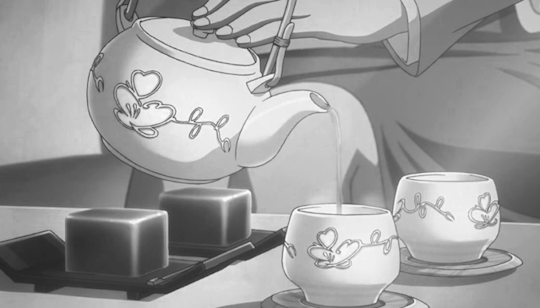
Hashire, Melos!: 8.9/10
Would you look at that? It’s the best arc of the series. Hashire, Melos was great. It had me going from beginning to end, and it’s the only arc that doesn’t have Masato Sakai playing the lead character. The art, the pacing, the storytelling, the story, the sound, the voice acting, and the art direction complemented each other so well. It made me far more interested in the original.
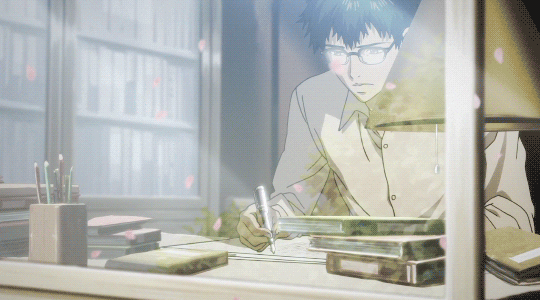
The Spider’s Thread: 6.6/10
If you look really close, you’ll notice that the creator of Bleach took over character design for this! It was okay. I found that it was a little cliche and lacklustre. Mamo is around so much that you probably have to do more than that to keep my attention, and this had the art going for it too. It just wasn’t that interesting. A heartless murderer is sent to hell after being executed. Moral of the story: Don’t be an asshole. Alright. Nice. I do understand that Ryuunosuke Akutagawa was one of the main establishers of the whole “Japanese Short Story” thing, but after seeing it so many times, I just didn’t get that same chill.
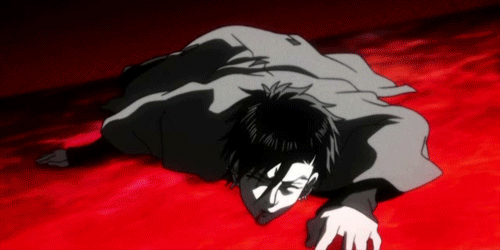
Hell Screen: 6.9/10
Another Akutagawa short story! This one had far more of an impact because this one hit closer to Akutagawa’s heart. Knowing the history of this piece of writing, you can see his desperation to stay relevant and true to his craft. It’s about a painter who wants to paint the town but finds out the city isn’t the bright light he sees in his mind. Everything goes ablaze. The art for this is stunning. I probably would’ve enjoyed this story more if it was placed in the middle of the series run rather than being the last story.

Recently Started
Africa no Salaryman
The animation for this is terrible. There is no way around it. However, at least it’s funny. Still, close to being on the chopping block. It has the papa lion who’s played by Akio Ohtsuka, the straight-man middle lizard played by Kenjirou Tsuda, and the scumbag toucan played by Hiro Shimono. Yes, they all play Hero Academia villains. The jokes are pretty good for me.
youtube
Given
Oh, would you look at that? It’s a music anime. *inhales* Music anime is a double-edged sword for me. I like having music interpreted and portrayed through one of my favourite mediums, but I don’t like them playing off music as some sort of easy gimmick and a joke. It’s like a shonen montage. “Let’s just have this guy train for two minutes and become a demigod”. But when you put an instrument into someone’s hand and demand the same, it sends me to another plane of angriness. So far, the romance is kind of cute... but Mafuyu kind of annoys me since his role in the BL dynamic is so clear just by his voice. Same with Uchida. You can only play so many thugs a season. Kyou? Good. Chika? Good. This guy? Good, but don’t do them all back-to-back! I don’t like the BL dynamic being so basic. However, my mind can be changed if done right.
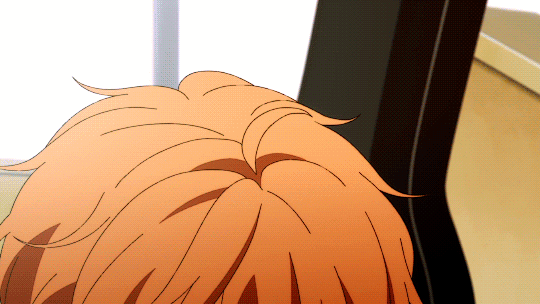
Shinsekai Yori
Very interesting premise, their eyes are cute, and I’m a sucker for these so I’m gonna stick with it.
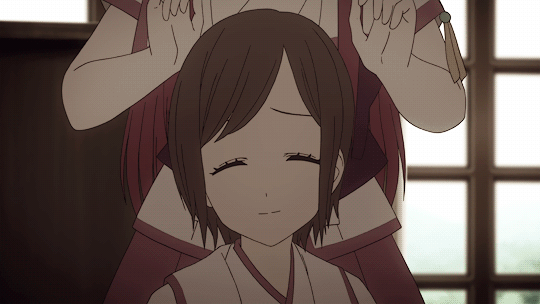
#dino watches anime#given#shinsekai yori#aoi bungaku#dazai osamu#natsume souseki#akutagawa ryuunosuke#ango sakaguchi#full metal panic#kara no kyoukai#saiunkoku monogatari#tokyo godfathers
94 notes
·
View notes